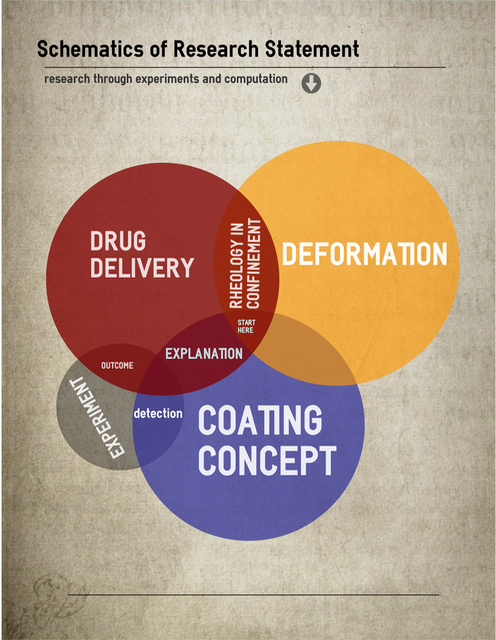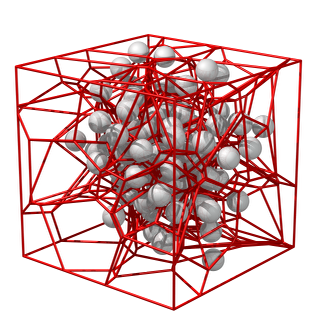My research interest lies primarily in non-Newtonian fluid’s behavior in response to external field in bulk and near wall and in presence of particles. A considerable portion of earlier research work addressed problems related to modeling response of colloidal hybrids for application ranging from drug delivery to enhanced oil recovery, surface charge effect and contact mechanics & capillary effects during drying of colloidal dispersion. My current research involves development of next generation pharmacokinetic model for therapeutic targeted drug delivery. A brief description of my research and potential area of research is mentioned below.

Hybrid complex fluids are made of colloid hard-core with polymer brushes. For battery research they are used for ion transportation. For gas absorption purposes it acts as porous support to screen molecules and hold active absorption agents. In drug delivery hybrid complex fluids are used as vehicles to carry important drugs. In this case the core is made of polymers like lysozyme polymer cores.
The deformable nanocarrier (NC) is made of polymer cores that have a huge molecular weight and it is difficult to address its structural dynamics using molecular dynamics technique. There is also a lack of mechanistic insight to predict selectivity of binding of the NC to inflamed or diseased tissue under physiologically relevant conditions in vasculature. In order to model deformable gel-based NC with internal nanostructure, structure of the deformable gel is coarse-grained based on theoretical model and experimental results while simulated annealing is used for computation. Brownian dynamics (BD) framework is incorporated to include hydrodynamic interactions. Equilibrium and steady shear rheological properties of the NC paved a way to understand the capability to carry drugs. BD near wall along with rheological response in bulk gives important insight that is essential for drug design and predicts its targeting capabilities to specific tissues which is important for clinical translation.
Nano organic hybrid materials are made of silica cores and PEG brushes which provide fluidity of the system and there is no unattached solvent in it. It is used primarily in energy innovation and gas adsorption and tested for effective recovery of petroleum crude oil. Most of the research work in this area were carried out for simple flows while most of the application like flow in confined spaces is related to complex flows. Primary goal of my research work has been the understanding the properties of these materials at a Brownian and mesoscale level along the lines of theoretical model5 of these materials. Based on this model the steady shear rheological properties4,5 and the origin of the transient response5,6 are investigated. Their response to shear is very similar to soft glassy fluid elements. A constitutive model3 for complex flows exhibiting a variety of local linear flows is derived and applied it to a complex stochastically varying flow of the fluid through an isotropic fixed bed of fibers. Transient response of polymer is investigated in a stochastically switching 4-roll mill.7

This project was primarily based on consolidation and cracking in drying colloidal dispersion. The work addressed fundamental understanding related to colloidal films broadly desiccation processes. Drying of colloidal dispersion was investigated through experiments and theory. If a dispersion of colloidal particle is allowed to dry, particles packing under a convective field (set by the evaporation) is in compression while the solvent from bulk, pass through porous bed of particles to reach the interface. This compression represented with a constitutive relation between stress-strain of the colloidal packed bed. Charge nature of the particles changes the conventional drying-consolidation profile9,10 while the presence of flaws in the packed region is effected due to an interplay between strain energy, stored in the particle network, and interfacial energy.8 Experiments were performed in rheometer (semi-confined geometry11,13) and in microchannels (confined geometry12). In semiconfined geometry the pressure required to open a crack from flaw was predicted while in confined geometry the additional effect, due to presence of boundaries and channels, were investigated and hence depicted an overall consolidation behavior.

My experience is mainly in the applied mechanics studies of complex fluids. I would like to further extend the methodologies developed for carriers like deformable NCs and particle with shape memory to include and resolve internal and inhomogeneous / anisotropic stresses and strains near wall.2,14 Other than drug delivery, I plan to study rodlike micelles in a semi dilute concentration. Rodlike micelles can be an important colloidal self-assembly for drag reduction in oil pipelines and hot water transportation. I plan to do experiments in 4-roll mill to understand the response to rodlike micelles in a variety of flows and extend the present understanding of soft glassy fluid elements to rodlike micelles, in general FENE dumbbells. I am also interested in packing and sintering of alumina colloids in presence and absence of a heat source. Alumina is widely used as refractory coatings and catalyst. The transparency of alumina film and wide range of properties extend its application in optics as well. I would like to study alumina film formation through theory and experiments to predict packing1 and its effect on film properties like shear modulus, yielding characteristics etc.

Further training and experience can be obtained in collaborations, in experimental case studies, and in analysis of experimental results with models developed from first principals (shown in figure below). My intention is to have the future research work (described above) be a part of my future collaborative efforts that will further direct me towards open problems to which I can apply my theoretical and experimental skills in the development of useful and novel methodologies. Finally my contribution to research will expand the range of expertise that the department currently offers and add to the variety of computational and experimental resources.
